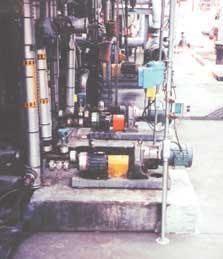New Industrial Pump Features Low-Pulse Output
The Hydra-Cell is a positive displacement pump with smooth, low-pulse output. The drive shaft is rigidly held in the pump housing by a large tapered roller bearing at the rear of the shaft, and a smaller bearing at the front of the shaft. Sandwiched between another pair of large bearings is a fixed-angle cam or wobble plate. As the drive shaft turns, the wobble plate moves, oscillating forward and back to convert axial motion into linear motion. This complete pumping mechanism is submerged in a lubricating oil bath.
The wobble plate alternately moves three Hydra-Cell pistons. The pistons are filled with oil on their return stroke. A ball check valve in the bottom of the pistons ensures that the Hydra-Cells remain full of oil on their forward stroke. The oil balances the back side of the diaphragms and causes them to flex forward and back as the wobble plate moves, providing the pumping action.
To provide long diaphragm life, the Hydra-Cell hydraulically balances the diaphragm over the pump's complete pressure range. The hydraulically balanced diaphragm actually sees up to 2 psi pressure differential, regardless of the pressure of the fluid being delivered, up to 2500 psi.
Each diaphragm has its own pumping chamber that contains an inlet and outlet self-aligning check valve assembly. As the diaphragms move back, fluid enters the pump through a common inlet and passes through a manifold to one of the inlet check valves. On the forward stroke, the diaphragm forces this fluid out of the discharge check valve, and through the manifold to a common outlet. The diaphragms, equally spaced 120° from one another, operate sequentially to provide constant, low-pulse flow. A pressure regulating valve is typically installed on the outlet side of the pump to regulate the pressure to downstream processes or equipment.
Hydra-Cell pumps are very efficient, with typical operation at or above 80% efficiency. They can be driven (belt, gear or direct) by electric, air or hydraulic motors, allowing system designers flexibility in drive selection. The high efficiency offers energy savings over comparable pumps. Hydra-Cell pumps are available in flow rates from 0.2 to 37 gpm at discharge pressures from 30 to 2500 psi.
Hydra-Cell in Action
Solutia is a company that uses its skills in applied chemistry to create solutions for customers whose products are used by consumers every day.
The team at Solutia's Decatur, AL, plant performed an analysis on two pumps that were used to pump a slurry of abrasive catalyst, organic chemicals and water. The analysis revealed that over a 12 month period the company lost $71,000 in production down-time and spent $64,500 in maintenance labor and materials, for a total of $135,500.
Solutia replaced the pumps with a Hydra-Cell H-25 Series triplex diaphragm pump from Wanner Engineering (www.hydra-cell.com, Minneapolis, MN) to provide a steady, low pulse flow to the process. This eliminated piping check valve failures and pipe pluggage. Large clearances in the inlet and outlet check valves enable solids to freely pass through the pump. The wide variety of materials of construction allowed the use of abrasive-resistant parts in the high wear areas.
The pump is designed so that the diaphragms are hydraulically balanced, thus eliminating ruptured diaphragms. The simple construction of the pump enables mechanics to pull the pump, replace check valves and diaphragms, and reinstall the pump in just two hours. The pump speed is controlled with a variable speed motor and wired into the company's Distributed Control System, enabling Solutia to control flow remotely.
Solutia was able to test the Hydra-Cell pump for a 90-day trial period. If the company was unsatisfied with the performance of the pump for any reason it could have returned the pump with no questions asked. The project paid for itself in five months.

